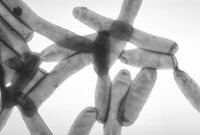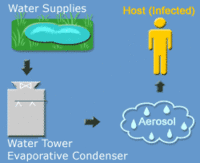Legionella pneumophila: Difference between revisions
imported>Bilal Hanif No edit summary |
imported>Bilal Hanif No edit summary |
||
| Line 15: | Line 15: | ||
| binomial_authority = | | binomial_authority = | ||
}} | }} | ||
| Line 49: | Line 50: | ||
==Cell structure and metabolism== | ==Cell structure and metabolism== | ||
L. pneumophila is a flagellated gram negative bacteria. It has a rod-like (bacillus) shape, and use aerobic respiration. They are unable to capsulate, sporulate or ferment. As for light, they do not have pigments and are unable to carry on autflouresce. Although it is a gram negative bacteria, it is still difficult to stain L. pneumophila due to certain lippolysaccharides in their cell membrane. A minimum of 35 antigens have already been identified from L. pneumophila. | L. pneumophila is a flagellated gram negative bacteria. It has a rod-like (bacillus) shape, and use aerobic respiration. They are unable to capsulate, sporulate or ferment. As for light, they do not have pigments and are unable to carry on autflouresce. Although it is a gram negative bacteria, it is still difficult to stain L. pneumophila due to certain lippolysaccharides in their cell membrane. A minimum of 35 antigens have already been identified from L. pneumophila. As for the size, it is approximately 2 µm in length and 0.3-0.9 µm in width. The shape changes, by increasing the length, when under poor nutritional conditions. The cell membrane contains a lipopolysaccharide which initiates the immune response of the host. This lipopolysaccharide has been extensively researched. The lipopolysaccharide in L. pneumophila has a significantly weaker interaction with CD14 receptor proteins of others cell, compared to the interaction strength of lipopolysaccharides found in other bacteria, such as enterobacterial. This weaker interaction reduces the endotoxic effects of L. pneumophila. The antigens located on the cell membrane are used to identify the different serogroups in the genus pneumophila.<ref> Lederberg, Joshua et al. Legionella. Encyclopedia of Microbiology. Second Edition. Volume 3. San Diego, 2000. p. 19-20 </ref> | ||
==Ecology== | ==Ecology== | ||
Revision as of 10:58, 28 April 2009
For the course duration, the article is closed to outside editing. Of course you can always leave comments on the discussion page. The anticipated date of course completion is May 21, 2009. One month after that date at the latest, this notice shall be removed. Besides, many other Citizendium articles welcome your collaboration! |
| Legionella pneumophila | ||||||||||||||
|---|---|---|---|---|---|---|---|---|---|---|---|---|---|---|
 | ||||||||||||||
| Scientific classification | ||||||||||||||
| ||||||||||||||
| Binomial name | ||||||||||||||
| Legionella pneumophila |
Description and significance
Legionella pneumophila is a rod shaped, flagellated and a gram negative bacteria. L. pneumophila are aerobic and non-capsulated. It is known to be pathogenic to humans and leads to legionellosis or legionnaires’ disease. The name Legionnaires comes from an outbreak of this disease during a convention of American Legions in 1976.[1] L. pneumophila is determined to be the dominant human pathogen in its genus of 41 different species . It was first found to be pathogenic in 1976 when a group of men were found to be infected. It spread to more than 200 individuals and led to 34 casualties. It was first isolated by inoculation of a guinea pig with the blood sample of an infected person in 1947.
Genome structure
There are three genomes from the species L. pneumophila that have been studied well. These are Legionella pneumophila str. Paris, Legionella pneumophila str. Lens and Legionella pneumophila ssp. Pneumophila str. Philadelphia 1. All three of these genomes have been completed recently between 2001 and 2004.
| Name | Genes | Base Pairs | Year |
|---|---|---|---|
| Legionella pneumophila str. Paris | 3136 | 3,503,610 | 2004 |
| Legionella pneumophila str. Lens | 3001 | 3,345,687 | 2004 |
| Legionella pneumophila ssp. Pneumophila str. Philadelphia 1 | 3002 | 3,397,754 | 2001 |
Cell structure and metabolism
L. pneumophila is a flagellated gram negative bacteria. It has a rod-like (bacillus) shape, and use aerobic respiration. They are unable to capsulate, sporulate or ferment. As for light, they do not have pigments and are unable to carry on autflouresce. Although it is a gram negative bacteria, it is still difficult to stain L. pneumophila due to certain lippolysaccharides in their cell membrane. A minimum of 35 antigens have already been identified from L. pneumophila. As for the size, it is approximately 2 µm in length and 0.3-0.9 µm in width. The shape changes, by increasing the length, when under poor nutritional conditions. The cell membrane contains a lipopolysaccharide which initiates the immune response of the host. This lipopolysaccharide has been extensively researched. The lipopolysaccharide in L. pneumophila has a significantly weaker interaction with CD14 receptor proteins of others cell, compared to the interaction strength of lipopolysaccharides found in other bacteria, such as enterobacterial. This weaker interaction reduces the endotoxic effects of L. pneumophila. The antigens located on the cell membrane are used to identify the different serogroups in the genus pneumophila.[2]
Ecology
In general L. pneumophila can be found in aquatic environments worldwide.[3] L. pneumophila can be found in many large water systems, such as those used in buildings. It often ends up in the heating and cooling components of residential apartments. If such water systems are left unchecked, it can lead to outbreaks of Legionnaires’’ disease can occur.[4] Furthermore studies have shown that L. pneumophila thrives in water tanks for two primary reasons. Firstly many water tanks show the presence of sediments, which acts as a nutrient source for L. pneumophila. Secondly many water tanks are kept at elevated temperature, which makes it easier for L. pneumophila to survive.[5]
Pathology
Infection by L. pneumophila in humans is called Legionnaires’ disease or Legionellosis. Once infected there are two possibilities: the person might develop pneumonia, which is the dangerous version of the disease or the person might develop Pontiac fever, which is usually nonfatal. Many cases of Legionnaires’ disease go unnoticed because infections of Legionnaires’ disease are often reported as respiratory infections and in some cases a treatment for respiratory infections can also treat the Legionnaires’ disease.[6] People of all ages are susceptible legionnaires’ disease but it is more fatal to people with chronic lung disease, smoking habits and a compromised immune system.[7] Furthermore legionnaires’ disease can’t be passed on directly from person to person. In fact the only way for it to be passed on is through aerosolization or aspiration of water[8] There are 41 different species in the genus Legionella and these are further divided into 64 serogroups. The serogroups 1, 4, and 6 are responsible for most human infections of Legionnaires’ disease. Serogroup 1 is determined to be the cause of 70-90% of such infections. Studies show approximately only 5-15% of Legionnaires’ disease cases are fatal. A recent case, in January 2009, of Legionnaires’ disease has occurred at a recently opened luxurious hotel in Dubai. Three individuals who had been residing at Westin Dubai Mina Seyahi Beach Resort reported severe illness after leaving the hotel. Furthermore one of the three individual, who was a famous Cricket Broadcaster in Britain, passed away after battling the disease for a short period. The other two individual continue to struggle with Legionnaires’’ disease. The hotel authorities have cooperated and allowed the testing for Legionella bacteria in the hotel; so far all results have returned negatively.[9]
| Year | Male | Female | Total |
|---|---|---|---|
| 1999 | 42 | 14 | 56 |
| 2000 | 125 | 29 | 154 |
| 2001 | 78 | 8 | 86 |
| 2002 | 139 | 29 | 167 |
| 2003 | 127 | 20 | 147 |
| 2004 | 151 | 9 | 160 |
| 2005 | 252 | 29 | 281 |
| 2006 | 452 | 66 | 518 |
| 2007 | 527 | 141 | 668 |
| 2008 | 529 | 157 | 686 |
Application to Biotechnology
Still researching on this topic… will be up by this weekend.
Current Research
Still researching on this topic…will be up by this weekend.
sub categories
- ↑ Legionellosis (Legionnaires' Disease): Information for adults from visualdxhealth
- ↑ Lederberg, Joshua et al. Legionella. Encyclopedia of Microbiology. Second Edition. Volume 3. San Diego, 2000. p. 19-20
- ↑ (enter reference)
- ↑ http://www.visualdxhealth.com/atlas/legionellosisLegionnairesDisease.htm
- ↑ Stout JE, Yu VL, Best MG. Ecology of Legionella pneumophila within water distribution systems. Appl Environ Microbiol. 1985. Volume 1. p. 221-228.
- ↑ http://www.visualdxhealth.com/atlas/legionellosisLegionnairesDisease.htm
- ↑ http://www.ehagroup.com/resources/pathogens/legionella-pneumophilia/
- ↑ http://www.ehagroup.com/resources/pathogens/legionella-pneumophilia/
- ↑ http://www.hotelchatter.com/tag/Hotel%20Sick
